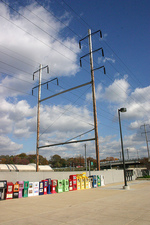PG building edge cities, neglecting Metro stations
Prince George’s County leaders are very proud that Konterra Town Center is moving forward. It’s a huge development at I-95 and the future Intercounty Connector in Laurel. It’s even bigger and just as auto-dependent as their other totally transit-inaccessible edge city, National Harbor, which, after building itself far from transit, started complaining about the lack of transit.
The county is working hard at making the same mistake with Konterra, which will generate a huge amount of traffic on the ICC, 95, and the Beltway. Konterra is “New Urbanism,” but New Urbanism in a highway-only area generates as much traffic as old sprawl. Meanwhile, Prince George’s County contains the first and second lowest ridership stations in the Metro system (Morgan Boulevard and Cheverly) among its 15 underutilized stations. Many PG County Metro stations have large, sparsely developed land around them, whether low-density housing, huge park-and-ride lots, industrial warehouses, or all of the above. And the eastern ends of the Orange and Blue Lines are the parts of the Metro system with the greatest excess capacity.
It may be a bit politically easier to build a huge development in the middle of nowhere. And I can understand the appeal of building a shiny new city without hewing to existing constraints or NIMBY neighbors. But it’s a recipe for a traffic disaster. The article quotes Dennis Cook, of the West Laurel Civic Association, who worries that Konterra isn’t planning the right numbers of jobs and residences to minimize the amount of new commuter traffic.
Maryland officials, with pressure from the developers, are pushing for a Green Line extension to BWI which would go through Konterra. That would be enormously expensive, and we already have a train to BWI: MARC. Instead of spending billions on the Green Line, Maryland should beef up MARC to transit-level service, perhaps adding extra passing tracks so more trains can coexist with Amtrak. Plus, MARC already goes through already-settled areas (like Laurel) which could benefit from development.
If Prince George’s had no place to build, a New Urban community would be better than more classic sprawl. But they have plenty of good places inside the Beltway and next to Metro stations.
Update: Ryan Avent argues Prince George’s has few appealing options, given their poor financial position, and better regional planning and financing could create a better outcome for everyone.

